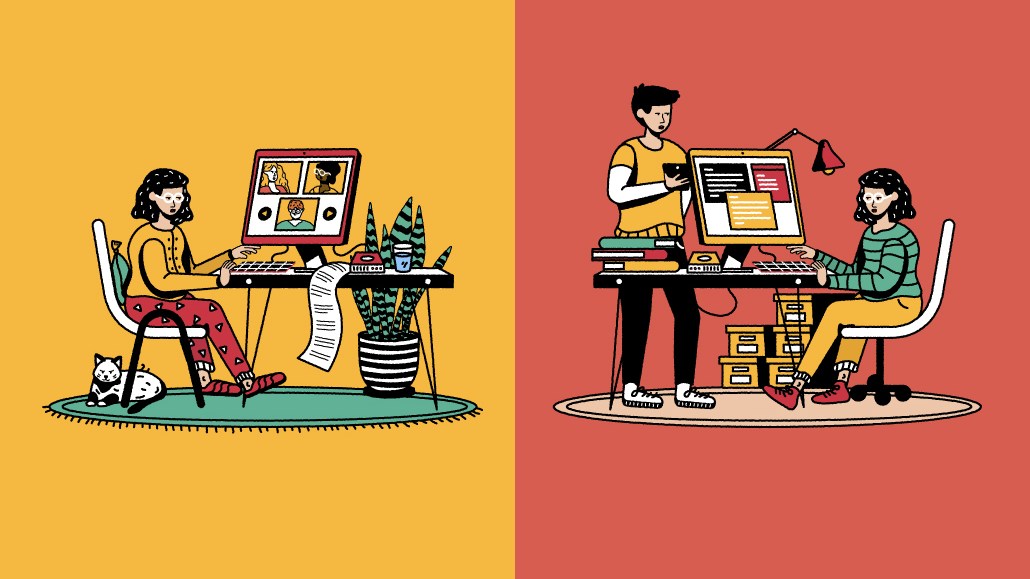Connect with execs from The New York Times, TIME, Dotdash Meredith and many more
Easing back into socializing: Employees express mixed emotions at being back in the office

Anyone returning to the office after months of working from home will most likely feel a mix of emotions.
They may be excited to see colleagues again and ready to collaborate and socialize in person, yet also feel anxious. They might worry about their safety and whether the old pressures and stresses will return. And there could also be tensions at work over the most trivial of things.
For example, a survey by Office Furniture Online reveals that one third of knowledge workers have argued over what music gets played in the office.
This may sound ridiculous, but neuro-linguistic coach Rebecca Lockwood insists that if music is selected carefully, it can improve staff morale and boost output. In fact, music could be one of the secret ingredients bosses use to create harmony so that people are both comfortable and productive.
And while the continued spread of the delta variant has caused widespread delays to office reopenings in the U.S., many workers are already back at their desks on a voluntary basis. For some that have returned for a couple of days a week, it’s been a surreal experience to find themselves with an entire floor to themselves. But for others, the experience has been positive.
At the New York office of magazine, website, and events business Future the mood is upbeat.
Lori Fromm, vp of Women’s Lifestyle magazine, was working as associate publisher for Hearst when its high-profile title Marie Claire was purchased by Future last May. She made the move too, but has only recently met her new Future colleagues face-to-face.
“Honestly, I was surprised by how excited I was to be returning to the office. I felt like a third grader preparing for her first day of school,” she said. “I packed my work bag and a lunch the night before and went to bed early. I dressed up, walked to the train and put on my game face.”
Future’s chief revenue officer Jason Webby felt the same. He joined the company in July 2020, but it was months before he saw his new colleagues in person.
“It wasn’t until I went into the office for the first time this June that I realized how much I missed being in the same room with my co-workers,” he said. “The office isn’t as full as it will be. In August we transitioned back to two days a week, but it will be three days a week in September.
“Those of us who are in now, seem really happy to see each other. There’s an element of fun that’s missing when you just go from video call to video call from home. Facilities are open, and I’m taking full advantage of our espresso machine.”
In the U.K., Kat Riekemann, account manager at PR company Words + Pixels, had looked forward to returning to the office, but she felt a little nervous. She had managed to meet some of her colleagues during and between the various Coronavirus lockdowns.
“I was anxious about returning to the intense work life I was used to before the pandemic,” she said. “However, since the restrictions have eased it has made a big difference being able to see colleagues face-to-face, have discussions and chats, and joke in person. I’ve found that it’s positively changed how I communicate with others remotely.”
Riekemann goes into the office two days a week and she is pleased that there are no plans to return full time.
“I think the office socials will change too. I’ve enjoyed the new social activities that aren’t completely focused on drinking,” she said. “We’ve started doing breakfast meets on a Monday morning, where the company provides a selection of breakfast foods for the team. Having the space to socialize, catch up on the weekend and ease back into socializing without the evening pressures has helped me massively in returning to an office environment.”
Natasha Lee is a global process expert for an automotive industry supplier based in Munich, Germany. She said going back to the office has been a strange experience.
“Having spent nearly 18 months in the shadow of COVID-19 it was great to be back, but at the same time I felt like a fish out of water. I felt like I was doing something quite naughty,” she said. “It was like a great escape back into the wild. The vibe improved as people relaxed and contact among colleagues increased.”
She said her company is managing the return well so that people feel safe. Employees are asked to still wear masks when not at a desk.
And Lee said it was great to be part of a work family again. “We are aiming to be in the office three days per week. I will select my days in line with my, let’s say, favorite colleagues.”
More in Media

Retail media meets publishing: News UK, Future and Ocado tap clean room tech for smarter data targeting
News UK, The Independent, Immediate Media and Future are teaming up with retail media network Ocado to test clean room-powered data matching.

From sidelines to spotlight: Esports events are putting creators center stage
Esports events’ embrace of content creators reflects advertisers’ changing priorities across both gaming and the wider culture. In the past, marketers viewed esports as one of the best ways to reach gamers. In 2025, brands are instead prioritizing creators in their outreach to audiences across demographics and interest areas, including gaming.

Condé Nast and Hearst strike Amazon AI licensing deals for Rufus
Condé Nast and Hearst have joined the New York Times in signing a licensing deal with Amazon for its AI-powered shopping assistant Rufus.








